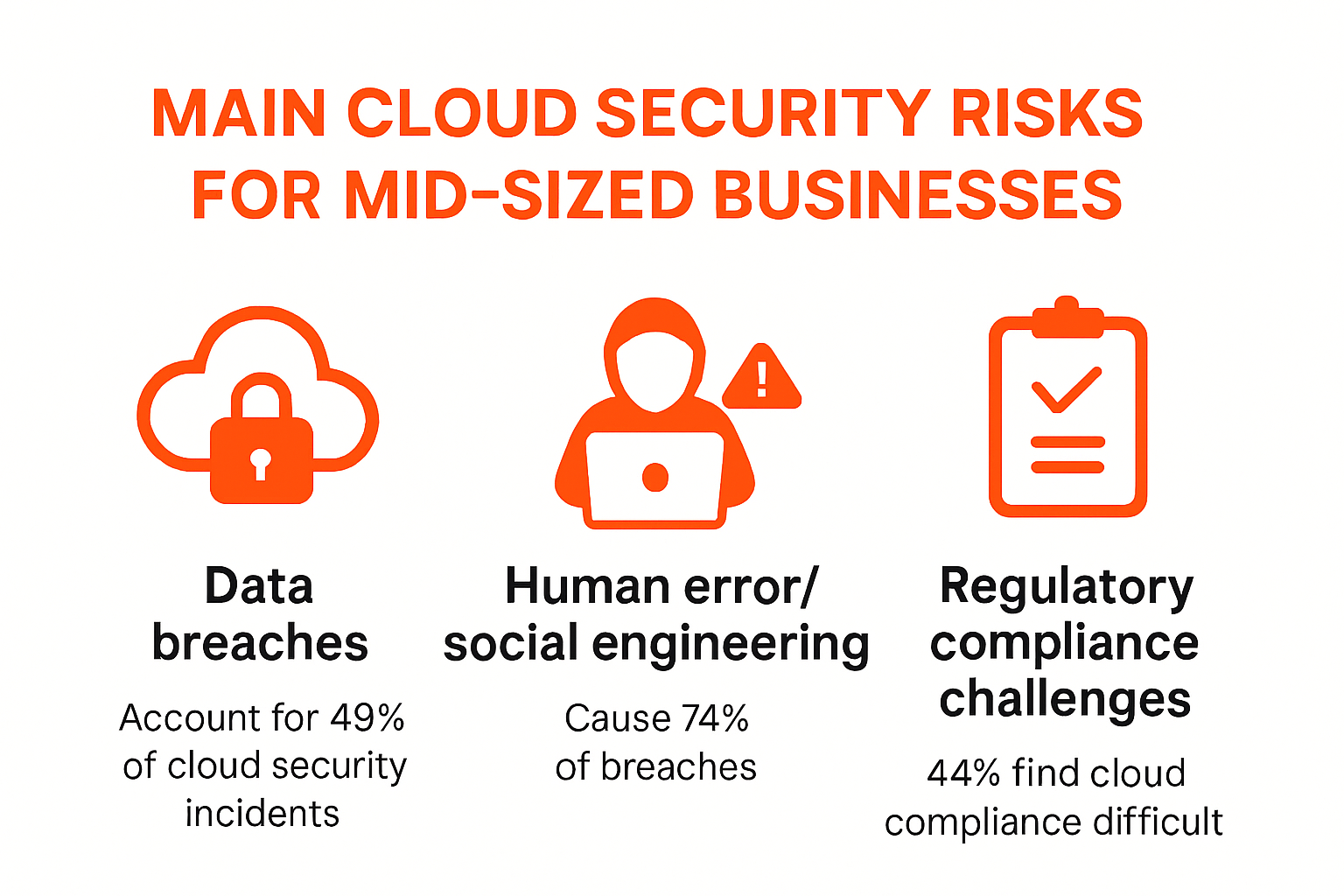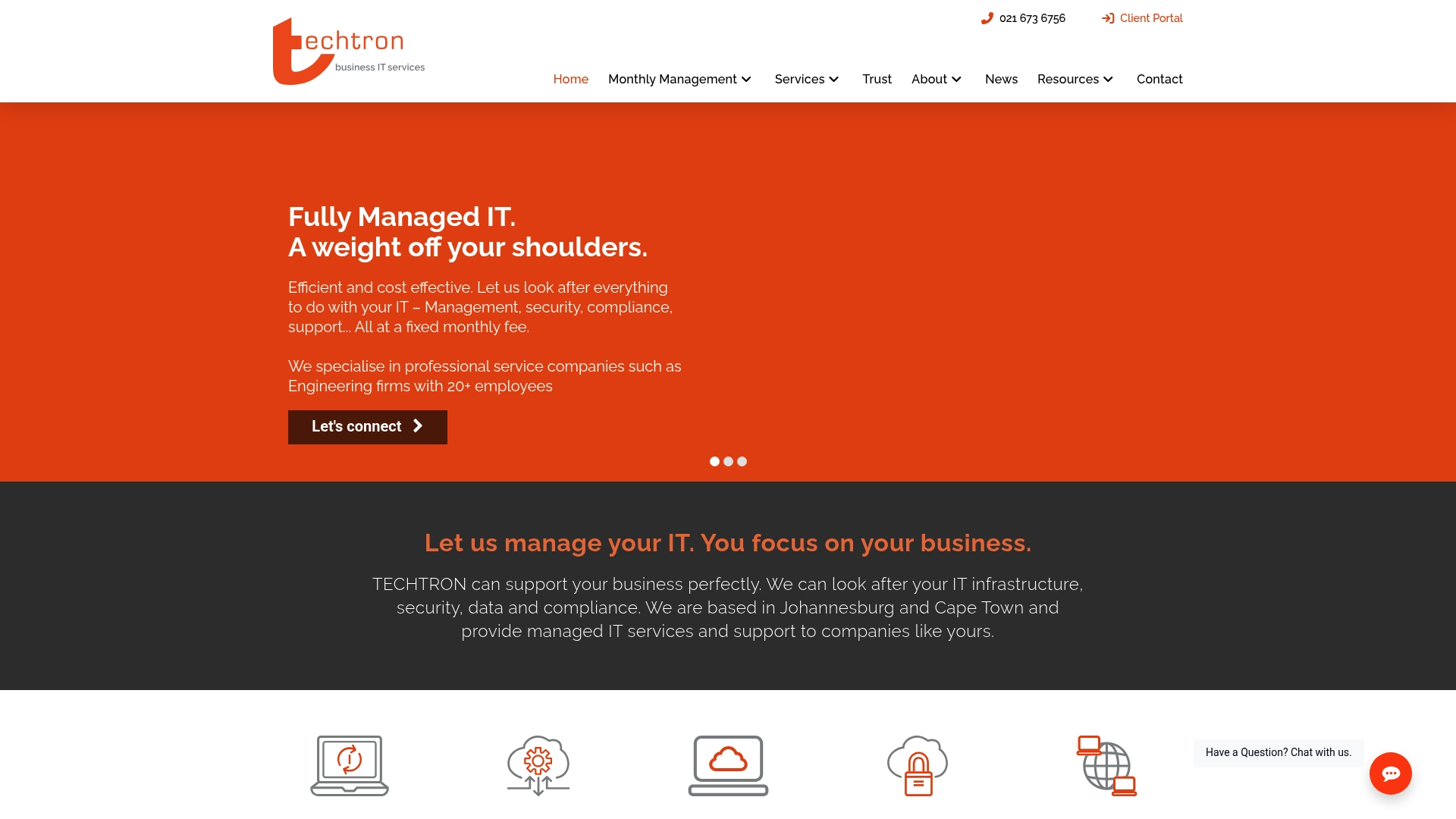Cloud Security Best Practices for SA Businesses 2025

Cloud security worries are keeping more and more South African business owners up at night. Get this. Almost half of mid-sized businesses hit by a cyberattack close their doors within six months. Most believe hackers only target big corporates but actually it’s the smaller teams with weaker defences in the firing line. The truth is protecting your data has become a business survival skill for 2025.
Table of Contents
- Key Cloud Security Risks For Mid-Sized Businesses
- Best Practices To Strengthen Cloud Security
- Meeting Compliance And Data Protection Requirements
- Choosing The Right Outsourced IT Security Partner
Quick Summary
| Takeaway | Explanation |
|---|---|
| Data Breach Vulnerabilities | Mid-sized businesses must prioritize proactive measures to combat data breach risks, which can be devastating, leading to significant failures post-cyberattack. |
| Implement Robust Identity and Access Management | Establish strong access controls, including multi-factor authentication and the principle of least privilege, to safeguard against unauthorized access. |
| Ongoing Compliance and Staff Training | Compliance is a continuous journey; ongoing staff training is essential to keep employees informed about regulatory requirements and possible security threats. |
| Evaluate IT Security Partners Carefully | Select an outsourced IT security partner based on technical expertise, service offerings, and cultural alignment to enhance your security posture. |
Key Cloud Security Risks for Mid-Sized Businesses
Mid-sized businesses face a complex landscape of cloud security challenges that can compromise their digital infrastructure and operational integrity. Understanding these risks is crucial for developing robust protection strategies.
Data Breach Vulnerabilities
Data breaches represent the most significant threat to mid-sized businesses leveraging cloud technologies. The U.S. Securities and Exchange Commission reveals a stark reality: approximately half of the businesses targeted by cyberattacks ultimately fail within six months. This statistic underscores the critical nature of proactive cloud security measures.
Misconfigured cloud environments create substantial exposure points. Weak access controls, improperly secured storage buckets, and inadequate encryption mechanisms can transform cloud platforms from productivity tools into potential liability nightmares. Cybercriminals continuously probe these vulnerabilities, seeking unauthorized entry points that can compromise entire organizational networks.
Social Engineering and Human Factor Risks
Human error remains a primary vector for cloud security breaches. The Australian Institute of Criminology highlights that inadequate staff training significantly increases organizational vulnerability. Employees unknowingly become potential security weak points through:
- Phishing Attacks: Sophisticated email scams designed to trick staff into revealing credentials
- Weak Password Practices: Using repetitive or easily guessable authentication methods
- Unauthorized Data Sharing: Accidentally exposing sensitive information through improper cloud platform usage
Regulatory Compliance Challenges
Mid-sized businesses must navigate complex regulatory landscapes while maintaining cloud security. The Financial Times reports that 94% of IT leaders experienced significant cyber attacks in 2023, with particular intensity in financial sectors. Compliance failures can result in substantial financial penalties and reputational damage.
Effective cloud security demands a multifaceted approach that combines technological solutions, comprehensive staff training, and continuous monitoring. Organizations must view security not as a one-time implementation but as an ongoing strategic priority that evolves alongside emerging digital threats.

To help summarise the major cloud security risks discussed for mid-sized businesses, the following table categorises each risk alongside its sources and consequences:
| Risk Type | Example Source(s) | Possible Consequences |
|---|---|---|
| Data Breach Vulnerabilities | Misconfigured cloud setups, weak access controls, poor encryption | Business failure, data loss, financial/legal penalties |
| Social Engineering & Human Factor | Phishing emails, inadequate staff training, weak passwords | Unauthorized access, data leaks, reputational damage |
| Regulatory Compliance Challenges | Complex regulations, failure to comply with laws | Fines, legal action, loss of trust |
Best Practices to Strengthen Cloud Security
Strengthening cloud security requires a strategic and comprehensive approach that addresses multiple layers of potential vulnerability. By implementing robust practices, businesses can significantly reduce their risk exposure and protect critical digital assets.
Implementing Robust Identity and Access Management
The National Security Agency emphasizes the critical importance of secure identity and access management as a foundational cloud security strategy. Organizations must develop sophisticated access control mechanisms that go beyond traditional username and password protections.
Key strategies include:
- Multi-Factor Authentication: Requiring multiple verification methods before granting system access
- Principle of Least Privilege: Limiting user access rights to the minimum permissions necessary for their specific role
- Regular Access Audits: Continuously reviewing and updating user permissions to maintain security integrity

Shared Responsibility and Infrastructure Management
The Cloud Security Alliance highlights the importance of understanding and implementing the cloud shared responsibility model. This approach requires clear delineation of security responsibilities between cloud service providers and organizational IT teams.
Successful implementation involves:
- Clearly defining security boundaries and responsibilities
- Developing comprehensive security policies that address both cloud provider and internal security protocols
- Creating detailed incident response and recovery plans
- Implementing secure automated deployment through infrastructure as code techniques
Continuous Monitoring and Security Training
Cloud security is not a static concept but a dynamic process requiring ongoing attention and adaptation. Organizations must invest in continuous monitoring technologies and comprehensive staff training programs. This approach ensures that security measures remain current and that employees understand their critical role in maintaining digital protection.
Effective continuous monitoring includes:
- Real-time threat detection systems
- Automated security scanning and vulnerability assessment tools
- Regular security awareness training for all staff members
- Periodic comprehensive security assessments and penetration testing
By adopting these best practices, mid-sized businesses can create a robust cloud security framework that protects against evolving digital threats. The key lies in a proactive, multilayered approach that combines technological solutions with human expertise and ongoing vigilance.
To clearly differentiate the main components of a robust cloud security framework, the table below summarises each practice and its specific focus:
| Best Practice | Primary Focus | Key Activities |
|---|---|---|
| Identity & Access Management | Safeguarding system entry points | MFA, least privilege, access audits |
| Shared Responsibility & Infra Management | Defining roles & boundaries | Security policies, incident response, infrastructure as code |
| Continuous Monitoring & Training | Ongoing threat readiness | Threat detection, vulnerability scans, staff training |
Meeting Compliance and Data Protection Requirements
Navigating the complex landscape of data protection and regulatory compliance requires a strategic and comprehensive approach for mid-sized businesses. Organizations must develop robust frameworks that address both legal requirements and potential security vulnerabilities.
Understanding Regulatory Frameworks
The National Institute of Standards and Technology provides critical guidance for organizations seeking to establish comprehensive compliance strategies. Their framework outlines essential security and privacy controls that protect organizational assets and ensure data integrity across cloud environments.
Key regulatory considerations include:
- Data Residency: Ensuring data storage meets geographic and jurisdictional requirements
- Encryption Standards: Implementing robust encryption mechanisms for data at rest and in transit
- Access Control: Developing granular permission structures that limit unauthorized data access
Risk Management and Documentation
The UK’s National Cyber Security Centre emphasizes the importance of comprehensive risk management strategies. Organizations must develop detailed documentation that demonstrates proactive compliance efforts and systematic approach to data protection.
Effective risk management involves:
- Creating comprehensive security policy documentation
- Conducting regular risk assessments
- Maintaining detailed audit trails of data handling processes
- Implementing continuous monitoring systems
Ongoing Compliance and Staff Training
Compliance is not a one-time achievement but a continuous process. Our guide on staff training highlights the critical role of employee education in maintaining regulatory standards. Staff must understand their responsibilities in protecting sensitive information and recognizing potential security risks.
The NIST Special Publication 800-144 recommends developing comprehensive training programs that:
- Educate employees about specific regulatory requirements
- Provide clear guidelines for data handling
- Simulate potential security scenarios
- Update training materials regularly to reflect evolving threats
Successful compliance requires a holistic approach that combines technological solutions, robust policies, and continuous staff education. Mid-sized businesses must view regulatory compliance not as a burden but as a strategic opportunity to enhance their overall security posture and build trust with stakeholders.
Choosing the Right Outsourced IT Security Partner
Selecting an appropriate outsourced IT security partner represents a critical strategic decision for mid-sized businesses seeking robust cloud security protection. The right partnership can transform an organization’s digital defense capabilities while providing specialized expertise and comprehensive protection.
Evaluating Technical Expertise and Security Frameworks
The National Institute of Standards and Technology emphasizes the importance of selecting partners who demonstrate advanced security architecture capabilities. Organizations must conduct thorough assessments of potential partners’ technical competencies and alignment with contemporary security frameworks.
Key evaluation criteria include:
- Certifications and Credentials: Verifying professional security certifications
- Technology Stack Compatibility: Ensuring seamless integration with existing infrastructure
- Demonstrated Zero Trust Architecture Understanding: Assessing partner’s commitment to advanced security principles
Comprehensive Service Offering Assessment
Beyond technical capabilities, businesses must evaluate the holistic service offerings of potential IT security partners. Learn more about selecting service agreements that provide comprehensive protection and flexible support models.
Critical service considerations encompass:
- Proactive threat monitoring capabilities
- Incident response and recovery protocols
- Scalable security solutions adaptable to organizational growth
- Transparent reporting and communication mechanisms
Cultural and Strategic Alignment
Successful outsourced IT security partnerships transcend technical specifications. Organizations must seek partners who understand their unique business context, regulatory environment, and strategic objectives.
Strategic alignment factors include:
- Cultural compatibility with organizational values
- Proven track record in your specific industry sector
- Commitment to continuous learning and technology adaptation
- Transparent pricing and contractual flexibility
Ultimately, choosing an outsourced IT security partner represents a nuanced decision requiring comprehensive due diligence. Mid-sized businesses must approach this selection process as a strategic investment in their long-term digital resilience and operational security. The right partnership can provide not just protection but a competitive advantage in an increasingly complex digital ecosystem.
Frequently Asked Questions
What are the key cloud security risks for mid-sized businesses in South Africa?
Mid-sized businesses face significant risks such as data breach vulnerabilities, social engineering attacks, and regulatory compliance challenges. Proper awareness and proactive measures are essential to mitigate these risks.
How can businesses enhance their cloud security?
To enhance cloud security, businesses should implement robust identity and access management, establish clear shared responsibility models, and invest in continuous monitoring and staff training to ensure a proactive security posture.
What is the importance of ongoing compliance and staff training in cloud security?
Ongoing compliance and staff training are crucial because they help ensure that employees remain aware of regulatory requirements and potential security threats, thereby reducing the risk of human error leading to breaches.
How do I choose the right outsourced IT security partner?
When choosing an outsourced IT security partner, consider their technical expertise, comprehensive service offerings, and cultural alignment with your business. A partner should demonstrate a solid understanding of security frameworks and be adaptable to your organization’s needs.
Secure Your Business Future with Expert Cloud Security
Reading about the real impact of data breaches, regulatory fines, and human error in cloud environments can make any mid-sized business worry about what tomorrow holds. South African companies, especially those juggling compliance and ever-changing threats, cannot afford to leave their cloud security to chance. If your team is stretched thin or concerned about misconfigurations and gaps in staff training, you do not have to solve this alone.

Let Techtron take the pressure off. We focus on proactive managed IT and cloud solutions built for busy businesses like yours. With professional IT management, backup, disaster recovery, and tailored cloud integration through Microsoft 365 and Azure, you can strengthen your defences and stay compliant. Do not wait for a breach to discover your vulnerabilities. Visit Techtron now and book your free consultation to secure your data and regain peace of mind.